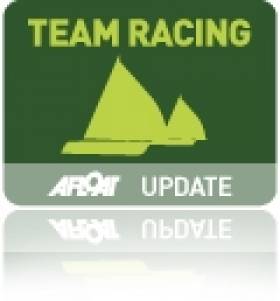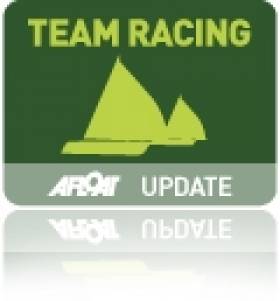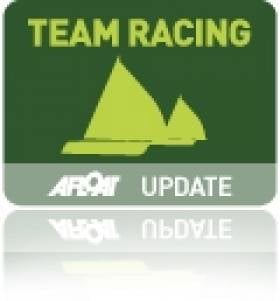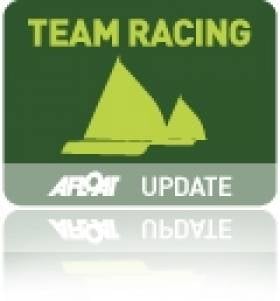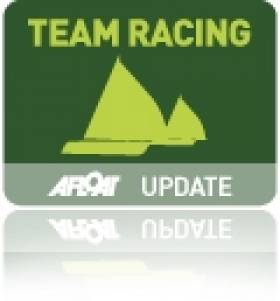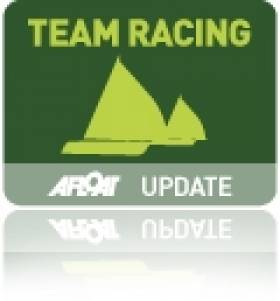Displaying items by tag: Team Racing
Schull to Stage Team Racing National Championships
#teamracing – Fresh from the success of the Junior All Ireland's at the weekend the Irish Team Racing National Championships are next up in Schull, West Cork on 10th and 11th November.
Organised by the Fastnet Marine and Outdoor Education Centre, the event will be sailed in the fleet of dinghies TR3.6 specially built for the ISAF Team Racing Worlds.
Teams from all the top Irish colleges, as well as the senior teams that continue to compete in this exciting form racing. Sailors from Schull will be numerous, continuing the tradition of the successful Schull
Youth team. Entries have already been received from British teams attracted by the sailing in West Cork, not to mention the legendary socialising.
Teams, both senior and youth, who wish to compete should contact the Irish Team Racing Association ([email protected]). A Notice of Race and Entry Form are attached to download below as word docs.
Entries Open for First 2K Team Racing Euros Next Month
#TEAM RACING - The inaugural EUROSAF Team Racing European 2 Keelboat Championships will be sailed at Lelystad in the Netherlands on 21-23 September.
Entries are invited from teams of six sailors (only four of one gender) with no weight limit. The entry fee is €380, with a €500 damage deposit.
2K team racing is a spectacular form of the sport, as it is rare, when teams are evenly balanced, for one team to get in to a commanding lead.
The team with the last boat loses, so the only safe winning position is to be first and second, with a unassailable lead over the third boat. In all other situations attack and defence continue right up to the finishing line.
Irish teams would benefit greatly from their previous team racing experience, particularly suitable for sailors who have experience of team racing but who find that the Fireflies seem to have shrunk since they were in college! On the other hand the Dutch and the Italians have been honing their skills in 2K racing for several years. All in all, this should be a fascinating event.
The Notice of Race and Entry Form are attached below, and the Irish Team Racing Association requests any team proposing to enter to contact them at [email protected].
West Cork Team Racers Win Under 21 Wilson Trophy
#WILSON TROPHY – West Cork's Schull Youth Team lifted the Under 21 trophy at the Wilson trophy at West Kirby in the UK this afternoon
Schull, one of three Irish team competing, finished the event half way down the leaderboard on eight wins. The team comprises four 18-year-olds and two 16-year-olds, all from Schull in southern Ireland, where team racing is part of their school curriculum. They competed at the ISAF Team Racing World Championship on home waters last year where they were narrowly beaten by West Kirby One (it came down to a penalty turn at the end of the deciding race). At the Wilson Trophy it was Schull Youth's turn.
"There is serious rivalry, but we beat them here - we got our revenge on their home turf," declared a satisfied Oisin O'Driscoll, a Schull Youth helm.
At one point on Saturday Schull Youth had pulled up to eighth overall, but O'Driscoll said they had made some silly mistakes due to their inexperience. "This was my first time at the Wilson Trophy – it is the most amazing team racing event ever. It is the best set-up I have ever seen. Every race is bang-bang-bang. We had over 200 races – it's incredible."
The 63rd Wilson Trophy will be remembered as the sunniest and windiest on record, but also for being the first time, in as long as anyone can remember, that competition at West Kirby Sailing Club's British Open Team Racing Championship had to be cut short mid-way through the quarter finals.
Ireland's two other teams Royal St. George YC and Howth YC finished tenth and 11th respectively. Dun Laoghaire's John Sheehy was the guest speaker at the event and Rachel McManus received the Joyce Evans Trophy. Full results table here. Below youtube footage of the race between Schull Youth and Royal Lymington YC 2012.
Because of this the final results reverted to the last complete round, or round 16 of the Wilson Trophy's Swiss league, where local favourites West Kirby Hawks had come out on top, followed by New Forest Pirates.
Racing today started at 0800 in 12 knots, the wind having backed into the west overnight. This enabled the race management team to bring the number of rounds completed up to 16, or an amazing 240 races sailed for the thirty teams taking part. Unfortunately, just as the final rounds were starting, the wind built significantly. The teams were sent back to fit smaller mainsails and the quarterfinals eventually got underway with the gathered crowd on the stadium seating adding their own unique commentary to the proceedings. Sadly the wind continued to build and with this came damage - jib tensioners and main halyards parting company and a broken rudder.
The big conditions were forecast, only for later in the afternoon, as Principle Race Officer Adam Whittle explained: "The wind came in a lot earlier than it was meant to. It was gusting 36 knots at Hilbre [the weather station nearby] and it just wasn't feasible to continue. We were having break downs and people were getting injured. It wasn't team racing – it was survival. Having sailed 16 rounds in perfect team racing conditions, I thought it would have been wrong of us to carry on."
Having suffered defeats to a US team in the last two Wilson Trophy finals, West Kirby Hawks finally came out on top for the first time since 2009.
Hawks helmsman Andy Cornah said they were right to stop racing. "The problem with these conditions is you are not team racing, you are just trying to get the boats around the course and it changes it a lot and it's not what you want."
West Kirby Hawks started the day on the back foot, a win behind Wessex Exempt and Royal Thames Red, but an excellent morning saw them complete the league in the lead, the sole team on 12 wins, ahead of New Forest Pirates, Tabby Cats, West Kirby SC and Wessex Exempt on 11.
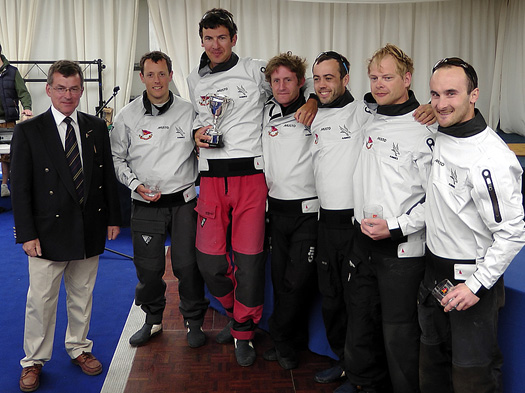
Winners West Kirby Hawks. Photo: James Boyd
"Yesterday was a little bit frustrating and we dropped a few races, which we were disappointed about," admitted Cornah. "We knew this forecast was here today and winning the league would be important, so we just forgot about yesterday and moved on and put a good series together."
West Kirby Hawks has a 'new' boat this season sailed by Matt Findlay and Toby Lewis, after Dom Johnson and Debs Steele retired following their ISAF Team Racing World Championship victory last year. However in a one-off appearance Johnson and Steele returned to this Wilson Trophy with New Forest Pirates and, clearly having lost none of their skill, came home second with Stuart and Jane Hudson and Owen Modral and Claire Wood.
Dom Johnson explained: "We are taking some time out and are not campaigning at the moment, so we took the opportunity to reform an old team we used to sail together as. My team mates haven't really done any team racing for the last four years, so it was nice to come back and do the best team racing event of the calendar and have some fun. We were really chuffed to end up with second place."
A highlight was beating the West Kirby Hawks early on yesterday, although they were subsequently beaten by the eventual victors when the two teams came head to head earlier today.
As to terminating racing, Johnson added: "It is a shame we haven't been able to finish off the event, but I think they made the right call – I snapped a rudder in the last race and it was a bit of a melee. We were at that stage of breeze where things were starting to give up. It must have been blowing over 30 knots in some of those gusts and masts and ripped sails would have been next."
Despite the weather not co-operating, West Kirby Sailing Club Commodore Chris Riley was satisfied with this year's event. "I think it has gone very well. It is a shame about the weather at the beginning and at the end, but that's sailing. This morning and Saturday the weather was perfect and we got over 200 races in and that was fantastic. We can't complain and all the competitors are very very happy. It is just a shame we didn't get the finals in."
#WILSON TROPHY – Were the Wilson Trophy a speed sailing event, then today would have been perfect with sunshine and 20+ knot winds this afternoon . Unfortunately with the wind gusting up to 36 knots in the morning, racing was unable to take place at West Kirby Sailing Club's British Open Team Racing Championship, despite one false start at 1600.
"It dropped to mid-20s and continued to drop and then when I announced to the competitors that we'd go, we had had 20 minutes of 14-15 knots - so sailable conditions - then unfortunately it came back up," explained Principle Race Officer, Adam Whittle. "Yesterday when the tide turned, the wind went as well and I thought it would do the same today and the Hilbre forecast said it was dropping, but unfortunately that wasn't what happened."
Racing will now commence at 0800 tomorrow when conditions are looking more sedate, with 10 knots and sunshine forecast. "In the history of doing two and a half days we have never lost a half day, so it is a shame," admitted Whittle.
At the Wilson Trophy the great and good of team racing are instead reluctantly filling their time at West Kirby Sailing Club's bar. Among them is Steve Tylecote, author of Team Racing For Sailboats, who has competed at this event around 22 times and reckons he's won it six or seven times.
"It is a tough call with a very, very enthusiastic bunch of sailors here," Tylecote said of the lack of play today. "The Race Officer can never win – do they get lynched by the sailors or the owners of the boats? If it was the end of the regatta and we were in the knock-out phase, they would have gone sailing with reefed mains. One of the things they could consider is racing without jibs as well, but they have never done that here yet."
Tylecote is competing with the Rutland Raiders, a local team from Rutland with a line-up that includes former Olympic Finn turned Musto Skiff sailor, Richard Stenhouse.
Making the trip across from Ireland is Darragh O'Connor, a helm with the Howth Yacht Club team. This is only O'Connor's second participation at the Wilson Trophy, although he wishes he'd been able to come more. "I was asked four or five times over university to do it, but it always clashed with college exams. I finally finished college a couple of years ago and I have been doing it ever since and hopefully I'll be back for a lot more."
Only two of the six-strong line-up are Howth Yacht Club members, but O'Connor says they sail a lot out of that club, which also kindly put up some money to help send them across from Ireland to compete at West Kirby this weekend. Last year O'Connor's team narrowly missed out on reaching the quarter finals. "We hope to step it up this year and if we get to the quarter finals, we'll be very happy."
Personally O'Connor heralds from Schull in West Cork, which is where the ISAF Team Racing World Championship was held last year. Schull has this year sent a youth team to the Wilson Trophy.
As to not racing today, O'Connor agrees with the ultimate call not to go racing. "It is better to have good racing than forced. It takes away from team racing and puts it into survival mode."
Irish Sailors in the Hunt for British Team Racing Trophy
#TEAM RACING – West Kirby Sailing Club's Wilson Trophy fires up at 1300 tomorrow, Friday 11th May, with 30 teams competing for the British Open Team Racing Championship title. The event is set to be a windy one, the forecast showing gusts of up to 18 knots on Friday, building into the 20s on Sunday afternoon.
The majority of teams competing at the 63rd Wilson Trophy this year are from the UK, but three come from Ireland and two have made the journey across from the USA for the three day long event.
From Guilford, Connecticut, Colin Gordon is one of the helms in the team Wise Old Men and this year will be sailing his 16th Wilson Trophy. The Wise Old Men typically come from a group of 20 based on the US east coast between New York City and Boston, but this year is more an Anglo-American mix including helms John Greenland and West Kirby's own Jamie Marston.
Wise Old Men occasionally reach the quarters or semi-finals, but have yet to make it to the finals. Of their prospects at this year's Wilson Trophy, Gordon advises: "We will use our 'old man' guile and wile to occasionally pick off the unsuspecting youngster, but we'll see how we do..."
So what is the attraction of the Wilson Trophy that is bringing him back to West Kirby for a 16th time? "It is that perfect combination of the best dinghy team racing in the world, the best umpires in the world, the best race management in the world – the envelope of good team racing and good race management is always led by this regatta and this club. The advancements and the innovations made at this regatta filter across the pond and around the world to racing regattas over the subsequent years – it is always where it evolves.
"And the social side is outstanding - because I have been coming for a long time, it is great way to see a bunch of friends at the same," says Gordon, who lived in the UK for three years during the 1990s. "It is a great trip for US team racers. We just don't have anything like it."
Another long term competitor at the Wilson Trophy is Debs Steele, a retired army Colonel, who first competed when she was a junior subaltern for the Army team in the late 1980s. She has since sailed at the event with the Combined Services, Spinnaker, RYA 1, New Forest Pirates and West Kirby Hawks. She is a five time winner, most recently with the Hawks in 2009 and runner-up last year.
However after the Hawks won the World Team Racing Championship in Ireland last year, Steele and her helm Dom Johnson retired from the all-conquering Hawks. "My helm Dom Johnson needed some family time, so our time was limited for training and competing," Steele explains.
This year she returns to the Wilson Trophy with New Forest Pirates and admits that this will be the first time she has ever competed at the event with no training beforehand. "I think it will be fun, and if we can string some decent results together in the early stages I expect our team performance to improve exponentially over the three days. The special thing about our team is that all of the helms are from the old New Forest Pirates team [twice winners previously and runners-up once]. So we sailed together pretty successfully in the past - and we are all friends.
"The Wilson is simply the best team racing event in the World. It has superb facilities, evenly matched flights of boats, a brilliant and hard-working shore back-up team, excellent administration and utterly fantastic racing within an ingenious Swiss League programme and to cap it, probably some of the best team racing umpires in the world. In addition, the social scene is cool and the Saturday evening Wilson dinner has to be attended to be fully appreciated."
But the Wilson Trophy is not only for seasoned competitors. Team racing is a popular pastime for university sailing clubs and at least eight teams competing at the Wilson Trophy represent universities.
For example Ed Morris has competed in the Wilson Trophy four times previously, twice for Spinnaker and then representing Southampton and Durham universities. This year he is competing with a BUSA (British Universities Sailing Association) team, who he admits haven't sailed together before but includes individuals who have done well previously with their respective university teams.
"The Wilson Trophy is simply the Best Team Racing there is," Morris enthuses. "This is for a variety of reasons: Firstly the venue is brilliant, with reliable breeze and the feeling of being on the sea without the pain that tides and currents cause in team racing. On top of this, the whole event is a master class in organisation; the Race committee is first class being both friendly, but fair and proper - and always starts with ruthless efficiency at 0757!
"Furthermore the event has the best umpire team of any event in the world, assembled from across the globe. Knowing that every race is fully umpired is amazing and you know that you will get consistency from the umpires. The flights of boats are always perfectly matched and of good quality. Off the water, the club lays on a fantastic social program that makes the event even more enjoyable.
"I think this combination of great sailing and socializing means that the best teams want to come and win the coveted Wilson Trophy which only serves to make it a better regatta.
"Finally it is worth remembering the whole membership of WKSC who work so hard during the event; from rigging and de-rigging, to the helping with the socials and finally most crucially hosting teams. By keeping the members closely involved, it gives the event a really special local feel that is often missing from the large international sailing events."
Howth and Royal St. George Line-up for Wilson Trophy
#TEAM RACING – Ireland is fielding two of the 32 teams at one of international team racing's most historic competitions, the Wilson Trophy, which sets sail on Friday 11th May. The three day event is hosted by West Kirby Sailing Club. With 30 teams competing on the Wirral peninsula for this year's British Open Team Racing Championship, the form going into the event is anything but certain.
Dublin's Howth Yacht Club and Royal St. George Yacht Club are sending teams. The Royal St George Yacht Club Team is a mix of the Gladiators and Knights teams. All of this team have sailed in the Quarter Finals of the Wilson before and as such must be seen as the best Irish hope.
Sailing for Royal St. George Yacht Club is Marty O'Leary and Rachel Macmanus, John Sheehy and Michelle Rowley, Johnny O'Dowd and Rebecca Killian.
The Howth team (who were IRL 2 in ISAF Team Racing Worlds September 2011) is Darragh O' Connor and Hannah Herlihy, Simon Rattigan and Lynn Reilly, George Kingston and Sonia Minihane.
This year marks the 63th occasion the Wilson Trophy has been held with racing taking place as usual between three boat teams sailing Fireflies on West Kirby's Marine Lake, a man-made lake rebuilt in 1986. Perhaps the original example of stadium sailing - now being adopted in the Olympic Games and even the America's Cup - a grandstand is set up around Marine Lake allowing spectators, well into their 1000s over the duration of the event, to get a bird's eye view of the action taking place on the water.
The Wilson Trophy uses the 'Swiss league system' before entering its knock-out stages. This is an on-going league system where after an initial ranking, teams move up and down the leagues according to their most recent results. The cumulative results from each round determine which teams will race which in the following round. These are followed by quarter and semi-finals before the grand finale rounds off the event on the Sunday afternoon.
With 30 three boat teams, there is a huge quantity of racing to get through in two and a half days, and this requires the competition to take place at a furious pace. In 2011 a total of 320 races were held with each team sailing 21 races before even getting to the knock-out rounds. For this reason races are kept short, lasting typically just six to eight minutes, sailed around an S-shaped course on Marine Lake.
Among the crews taking part are the cream of team racing talent, including two teams from the USA and three from Ireland. The benchmark could well be the West Kirby Hawks, runners-up at the Wilson Trophy for the last two years, winners of the UK Nationals three times and winners of the ISAF Team Racing World Championship in Ireland last September. However since the Worlds two of their six strong line-up have changed, with Toby Lewis and Mat Findlay replacing Dom Johnson and Deborah Steele.
West Kirby Hawks' Andrew Cornah is competing in his 14th Wilson Trophy, having sailed it every year since he was 17. "It is a fantastic event, the best team racing event on the planet," he says. "But I grew up in West Kirby knowing all about it. It is quite a mythical thing."
As to the Hawks' new recruits, in Toby Lewis they have a three time winner of the Endeavour Trophy champion of champions event. "He is a bit of a super crew," admits Cornah. And this should certainly help in their quest to recover the Wilson Trophy. "We have been in the final for the last three years, and losing the last two years, we are quite hungry to go and win it back," he adds.
Other teams likely to be in contention are the two from the Royal Thames Yacht Club - Red and Vultures – who have been consistently finished in the top three for the last couple of years. Perennial visitors from the USA are the Woonsocket Rockets, who regularly make the quarter and semi-finals of the Wilson Trophy. Among their line-up are sailors who finished second and third at last year's Worlds. Also capable of getting to the top of the leaderboard are the Cambridge Tabby Cats and Spinnaker Jedi, recent winners of the UKTRA RYA National Team Racing Championships at Bough Beach.
With ex-Hawks helm Dom Johnson returning to his original team, New Forest Pirates, it is also possible that they will see a return to their glory years when they enjoyed back-to-back victories in the Wilson Trophy over 2002-3.
Racing at the Wilson Trophy starts at 1300 on Friday, 11th May.
#TEAM RACING – Hosts Schull made a clean sweep of the prizes at a breezy edition of the Irish Schools Team Racing Championships 2012 sailed in West Cork last weekend (21st/22nd April) with 12 teams from Munster, Leinster and Connaught taking part.
The National Championships were raced in West Cork's own new TR3.6 dinghies.
Only 20 races took place on Saturday due to an increase in wind strength during the day. Racing was planned to start at 09.00 hours on Sunday morning but again due to wind strength sailing had to be delayed until midday.
After 47 races and a looming deadline to meet it was decided to race the three teams that had won all their races off against each other as they had not met in the round robin stages.
Schull 1, Schull 2 and CBC, Rochestown were all in with a chance depending on the results of these races. Schull 1 were eventual winners with Schull 2 runners up and CBC coming third.
Places for the other teams were as follows:
Irish Schools Team Racing Championships 2012 - RESULTS
Gonzaga and Rochestown 4th
Schoil Mhuire 5th
Belvedere 6th
St Andrews 7th
Calasanctius 8th
Rathdown 9th
Bish 10th
Rice 11th
UCD Third in British Sailing Championships
TEAM RACING – UCD Sailing team travelled to the home of British Team Racing in West Kirby last weekend and came home with one of Ireland's best ever results, a third overall at the British University Sailing Championships.
At the end of March, UCD Sailing Club broke their long drought when their first Team won the IUSA Intervarsity Championship beating Trinity in the Final. This result enabled them to qualify for the British University Sailing Association (BUSA) Championship from the 11-13 April UCD 1 representing IUSA and Ireland at this select 32-team event. This was a closed entry event with over 200 British Teams having to ensure qualification. After 2011, this was only the second time Ireland were lucky enough to be given an automatic single spot allocation. It took place at West Kirby SC, Liverpool known as the home of British Team Racing and the venue for the coveted Wilson Trophy every year. It was superbly run and organised by University of Liverpool.
Travelling to and from by the Dublin-Liverpool ferry, the team assembled on Tuesday ahead of the three intense days racing Wednesday to Friday. Aidan McLaverty travelled from Edinburgh having just won the Scottish SUSA Championship with an Open Team so confidence was high before the first day.
Wednesday dawned to clear skies, sun and beautiful wind. It could not have been any better. The format of racing followed that of a Swiss-League whereby as every race was completed, depending on the result of that race chose your next opponent so that teams of similar win-percentage raced those teams around them continually. Racing soon got underway in typical on-time British fashion. Racing was intense, incredibly tight with the level of competition colossal. For a first day out and adjusting to sailing at a much higher standard of racing that the norm, UCD finished with 4 wins from 7 after Day 1.
Thursday awoke to more perfect conditions. 10-12 knots and an earlier start time meant many more races should be completed. Keen to improve on the day before, UCD in the first seven races were immense; winning starts with ruthless tactics around the course to move their way rapidly up the leader board including notable scalps against Oxford, Southampton, Durham, Swansea and Bristol. They occupied top position after 15 rounds for a period before losses to Cambridge and the other Southampton Day moved them back to 3rd at the end of Day 2. However, a clear marker had been laid down, enough to worry the opposition ahead of Day 3 Finals.
On Friday, the final day of racing, it was not the conditions from the days before. It was much lighter, shiftier, and unpredictable with conditions ever changing. More Swiss-League racing was completed with UCD achieving wins over Oxford and Durham in the morning to ensure their place in the quarter-finals where it was so, so close from 1st place to 10th place.
UCD faced Durham Blue again in their quarter-final and true to form, although losing their first race in the best-of-three encounter, they prevailed 2-1 to move into Semi-Finals. Here they would meet Oxford White, defending champions, a team they had raced twice already having won once and lost once to them already. In the first race, UCD looked comfortable off the start line when a huge right hand-shift put paid to their chances promoting Oxford to a strong 1-2 to take the first race with UCD unable to get close. In the second race, once the course had been re-laid, they raced again and this time unfortunately UCD misread the windward mark. This dropped them from a winning position and again handed it to Oxford. They made no mistake to win the match 2-0 and strike a devastating blow in UCD hearts.
The Final of the BUSA Championship was to be decided between Oxford White and Southampton Turquoise while UCD Ireland took on Southampton Magenta. In the best-of-three encounter, clearly still thinking of the semi-final they lost the first, however in the second and third races they improved, sailed better and won both races to secure the Petite final and 3rd Place in the BUSA Open Championship. Southampton beat Oxford 3-0 in the Final to deservedly take the title they had come so close to in 2011. For UCD, they were left reflecting on what could-have-been having beaten Southampton in Swiss-League. However they should be extremely happy with the overall result. It was the best Irish result ever at this such competitive team racing event; representing UCD and Ireland proudly on and off the water.
A great few days of racing, some of which will never be forgotten by this team but to do it required a lot of hard work over the year. We would like to thank University of Liverpool and West Kirby for hosting such a fantastic event as well as the students that allowed us to stay with them in their homes. Lastly we would like to thank UCD Sport, the rest of UCD SC and all our followers at home for their continuous and unanimous support throughout the few days. It really was a great help, we only wish you could have been there too.
UCD 1 Team:
Simon Doran & Aoife Cooney, Barry McCartin & Eimear McIvor, Aidan McLaverty & Bella Morehead
Results downloadable below
Gonzaga College Win Leinster School Sailing Championships
Dublin's Gonzaga College beat Rathdown School to win the Lenister Schools Team Racing Championships after a thrilling 45 rounds of competition. Third overall were Kilkenny College from an entry of ten schools.
The inaugural event was run in fair weather last Saturday by the Royal St George Yacht Club whose Club Firefly dinghies were chartered for the event.
Some competitors were slightly rusty team racers at the beginning but within 10 races the young sailors had mastered the game with lots of one-on-one match racing and all starts bang on the line. The spirit of the event was of competitive fun with a bunch of very well mannered sailors enjoying the banter in the ribs and on the change-over vessel when not competing in the schedule of 45 rapid succession races.
The rapid skill progress was clear demonstration of the effectiveness of team racing in skill development.
Post sailing all agreed this is the start of more schools activity. This year sees the inauguration of Leinster Schools Team Sailing as an ad-hoc committee set up by Chris Craig and David Williams, both of whom have sons in St Michael's College who own boats, and ran this event.
There was 3 Wednesday afternoon coaching sessions leading up to the event, with teams of two competing. These were sailed in competitors' own Fevas with the NYC also providing their Fevas FOC. Gonzaga, the event winners, dominated the coaching. More coaching events are planned.
In other countries local authorities facilitate schools sailing but in Ireland it's up to Clubs and volunteers to service this growing and fertile market, for the general good of the Sport and Schools.
The top four teams qualify for the Nationals Schools Team Racing Championships to be run by David Harte in Schull - April 21st/22nd.
The final result is as follows :-
2012 LEINSTER SCHOOL TEAM SAILING CHAMPIONSHIPS - RESULTS
1. Gonzaga College
2. Rathdown
3. Kilkenny
4. Belvedere College
5. St Andrews College
6. Mount Anville A
7. Mount Anville B
8. Loreto College
9. St Gerards
10. Loreto Dalkey
#TEAM RACING – The Royal St. George Yacht Club Team Racing Invitational was once Ireland's most prestigious team racing event. After a lapse of a few years, the club hosted a revived "George Invitational" on Saturday March 10th. One tradition remained unchanged, as the event was sailed in Firefly dinghies.
The seven teams could not have asked for more perfect conditions as the current elite of Irish team racing gathered for one day of intense sport. Competing teams included the Royal St. George, Howth Yacht Club, UL, UCC, UCD, TCD and a last minute wonder team, LGN. With a perfect 10 to 15 knot breeze blowing across Dun Laoghaire harbour from the East Wall and relatively clear skies the stage was set for a fantastic event.
The day saw the first use a new course aptly named the Starboard Boot. This provided 6 marks, instead of the usual 4, for teams to set traps and confound both their opponents and the umpires.
After an intial round robin, in which all teams sailed each other once, the fleet was split. The top 3 teams went up into a Gold Fleet and the bottom 4 went into a Silver Fleet. Both the Royal St. George and Howth Yacht Club teams easily topped the group but a re-sail of a race between UL and LGN was required to settle the 3rd place . UL won this race.
The Gold Fleet then raced each other twice in another round robin while the Silver Fleet raced each other once. The winner of the Silver fleet was then promoted to Gold, and the last Gold team was relegated for a further, deciding, round.
The Gold Fleet provided an exciting and technical display of team racing. Howth Yacht Club managed to narrowly beat both UL and the Royal St. George in the first half of the round robin. UL then lost to the Royal St George in a highly contested race with flags and umpire decisions flying left, right and centre! In the second half of the round robin a surprise upset saw UL defeating both the Royal St George and Howth Yacht Club and Royal St George losing once again to Howth Yacht Club. The Royal St. George, the favourites of the event were relegated to the Silver Fleet for the final round, with LGN promoted to Gold.
Howth Yacht Club put paid to any aspirations by the other two teams and soundly defeated both UL and LGN both times they met each team in the final round. With UL defeating LGN twice in the same round the results were:
Howth Yacht Club in 1st,
UL 2nd
LGN 3rd.
Royal St George easily topped Silver to take 4th
UCC 5th
UCD 6th
TCD 7th.
In conclusion, all competitors agreed it was probably the highest standard of team racing seen this season on. The event organiser, John Sheehy, the Royal St George Yacht Club, the umpires and volunteers are to be congratulated.
Next year the event will return to the traditional two-day format, with team racers scrubbing up on Saturday evening for dinner in the RstGYC dining room.
Lastly, good luck to Howth Yacht Club and Royal St. George who are heading to the Wilson Trophy in West Kirby in May. If the display of team racing just gone is anything to go by Ireland will be well represented at Europe's foremost team racing event. Incidentally, three of the umpires officiating in the "George Invitational" will also be travelling to West Kirby for the "Wilson".
Team racing continues in Dun Laoghaire with the Leinster Schools on 24th March and the Varsity Colours event on 31st. The Irish Team Racing Nationals will be sailed in Schull on 10th-11th November.
For more information regarding team racing contact: [email protected]





























